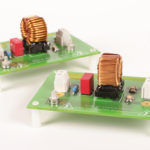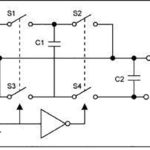Switched capacitor (SC) technology can be integrated into ICs and used for dc/dc converters, voltage inverters, voltage doublers, voltage dividers, and standalone dc/dc converters, ac/dc power supplies, and solar microinverters. This FAQ is focused on power conversion for the internet of things, portable, medical, automotive, computing and communications, and renewable energy applications. The next FAQ will consider “Emerging applications for switched capacitor power conversion,” including grid-scale power conversion and various possibilities for combining SC converters with state-of-the-art gallium-nitride (GaN) power switches to provide advanced power conversion solutions for electronic systems.
SC converters can be used to implement both regulated and unregulated power conversion topologies. They can be integrated with switching converters or low dropout linear regulators (LDOs) to produce hybrid power converters.
Charge pumps and embedded power conversion
Charge pumps are common SC power conversion circuits and can be used to decrease or increase voltages, often in low-power applications. Charge pumps use a switch to control the connection of a supply voltage across a capacitor. The drive frequency for the switch can range up to several MHz, minimizing the amount of capacitance needed since the more frequent transfer of charge minimizes the size of the charge transfer needed on each cycle to transfer a given amount of power. Charge pumps can double, triple, halve, invert and fractionally multiply or scale voltages (such as x2/3, x 4/3, x3/2, and so on), and generate arbitrary voltages depending on the operating mode of the controller and the topology of the charge pump.

For example, a voltage doubler uses a two-stage cycle. In the first stage, the capacitor (Cp in the image above) is connected across the supply voltage, charging it to the level of the supply. Next, the capacitor is switched and connected in series with the supply and the load, doubling the voltage across the load (the sum of the supply voltage and the capacitor voltage). An output filter capacitor (Co) is used to smooth the pulsing output of the charge pump.
SC power converters can provide an attractive alternative in embedded applications such as system-on-chip (SoC) ICs. SoCs use power, thermal, and performance (PTP) sensors distributed throughout the IC to monitor operating conditions. The use of PTP can result in a 23% increase in clock speed or up to a 40% reduction in power consumption. The PTP data in portable devices is used to implement several power-saving techniques such as dynamic power management (DPM) and dynamic voltage and frequency scaling (DVFS). DPM turns system blocks on and off into standby when they are not needed to save power. DVFS adjusts the power supply voltage and operating frequency based on workload to improve power system efficiency.

SC dc/dc converters using adaptively-biased pulse frequency modulation (ABPFM) combined with DVFS can maintain high efficiency over a wide current range compared with the use of DPM or DVFS alone. ABPFM) reduces the static power loss in a low-power DC-DC converter operating in standby/sleep mode. An ultra-low-power VCO is used to generate a wide range of frequencies suitable for switching converters. An SC converter can provide up to 70%, sometimes greater, efficiency over three decades of load current range. In these embedded power applications, SC converters offer better efficiency than linear regulators (LDOs), especially when the output voltage differs significantly from the input voltage.
Discrete dc/dc converters
In discrete dc/dc converters, when efficiency is a concern in discrete power applications, a charge pump has a fairly limited combination of output voltages it can provide. Charge pumps are well suited for doubling or inverting the input voltage. They also are good at providing half the input voltage. Combining a charge pump with a linear regulator can provide an alternative to inductor-based dc/dc converters. This combination can simplify the design, lowering the overall component count, reducing radiated electromagnetic interference (no magnetics), and result in a smaller and lower-profile total solution.

In the voltage halving charge pump shown above, initially switches S1 and S2 are closed, and switches S3 and S43 are open, placing the flying capacitor (the switched capacitor) and the output capacitor in series during the first half of the cycle. In the second half of the cycle, the switches are reversed with S1 and S2 open, and S3 and S4 closed, placing the two capacitors in parallel to obtain half the input voltage. This design can be used with positive and negative input voltages; if the input is positive, then the output is half the positive input. If the input is negative, the output is half the negative input. This voltage halving charge pump can be combined with a post-regulator, such as an LDO, to improve regulation.
Hybrid solution for 48V to 5V/12V intermediate bus power
So-called intermediate bus converters (IBCs) are used in many systems to convert a 48Vdc system distribution bus voltage to a lower local distribution voltage such as 12Vdc or 5Vdc. Traditionally, a power transformer has been used to provide isolation between the 48V section and the lower voltage section. In many applications, the 48V power bus is already isolated, eliminating the need for isolation in the IBC. In those cases, the conventional IBC can be replaced by a hybrid solution consisting of an SC converter and a synchronous buck switching converter. Using the SC converter to halve the input voltage, the input-to-output voltage ratio of the buck converter is reduced, and efficiency increases.

This hybrid approach can reduce the dc/dc converter solution size by up to 50% compared with buck converter alternatives. This size reduction is enabled because this solution can operate at a 3x higher switching frequency while delivering the same efficiency as the buck alternative. When operated at the same frequency as the buck alternative, the hybrid solution can deliver up to 3% efficiency improvement. This design can eliminate the inrush current typically associated with switched capacitor circuits by prebalancing the capacitors on startup. Other benefits include low EMI emissions due to a soft-switched front end. Hybrid solutions such as this are suited for non-isolated IBC applications in 48V automotive systems and power distribution in data and telecom applications.
AC/DC power
Another example of a power converter that combines an SC converter with an LDO is a low-power ac/dc power supply for electricity metering and similar applications. Using a 4:1 step-down SC converter and an LDO can provide an efficient, non-magnetic, ac/dc power solution with low standby power consumption. The SC step-down converter is used to lower the ac input voltage, followed by an active clamp of the rectified voltage. An LDO is used to regulate the dc down to the needed operating voltage for the system. With this architecture, the standby power is reduced to tens of milliwatts.

Compared with a conventional capacitor-drop stage to reduce the voltage, the step-down SC converter minimizes the needed capacitance value. Applications such as electricity metering, which demand reliable and magnetic tamper-proof performance, can benefit from this approach due to the lack of external magnetics. That makes complying with IEC 61000-4-8 simpler and minimizes the cost of magnetic shielding for the meter.
SC microinverter for solar energy
A novel microinverter architecture has been proposed that includes an SC-based Multilevel Energy Buffer and Voltage Modulator (MEB). The MEB is connected between the input capacitor and the inverter stage. The MEB consists of a Switched-Capacitor Energy Buffer (SCEB) and an optional Charge Control Circuit (CCC). The SCEB has one SC buffer capacitor and four switches connected in a full bridge. The MEB has three operating modes. When the line voltage is low, the MEB operates in step-up mode; when the line voltage is within the nominal band, the MEB operated in bypass mode; and when line voltage is high, the MEB operates in step-down mode.
The SCEB modulates the inverter stage’s input voltage (Vx) as the line voltage goes through a cycle, reducing the variations in the voltage conversion ratio of the inverter over the line cycle. That effectively reduces the required operating range of the microinverters high-frequency step-up operation and increases conversion efficiency.

The SCEB acts as an active energy buffer, reducing the total energy storage needed by separating the energy buffer voltage from the input (solar panel) voltage. Since the SCEB capacitors can be charged over a wider range than is possible for the buffer capacitor across the input, the needed capacitor size, and total energy storage can be reduced. The operation and control of the SCEB are independent of the input and output voltages. The SCEB is very efficient since it operates at low frequencies, switching at low multiples of the line frequency. The transformer’s primary side voltage is stepped up by the SCEB, reducing primary-side current and conduction losses.
This MEB architecture is expected to apply to other grid-connected inverters. The challenges faced by microinverters – wide operating voltage and power ranges and the need to buffer the twice-line-frequency energy – also exist in other single-phase grid-connected inverters.
That concludes this FAQ on SC power converters. The next FAQ on “Emerging applications for switched capacitor power conversion” will look at SC converters for high-voltage dc distribution in power grids, energy storage, and smart grid applications beginning with the possibilities for combining SC converters with gallium-nitride (GaN) power switches for novel power conversion architectures. You might also be interested in reading part 1 of this FAQ series on “Switched capacitor filters, amplifiers, and integrators.”
References
72 V Hybrid DC-to-DC Converter Reduces Intermediate Bus Converter Size by up to 50%, Analog Devices
A Multilevel Energy Buffer and Voltage Modulator for Grid-Interfaced Micro-Inverters, CORE
Charge pump, Wikipedia
Clever Circuit Improves Efficiency of Charge Pump Plus Linear Regulator Solution, Analog Devices
High-Efficiency Switched-Capacitor DC-DC Converter with Three Decades of Load Current Range Using Adaptively-Biased PFM, MDPI







Leave a Reply